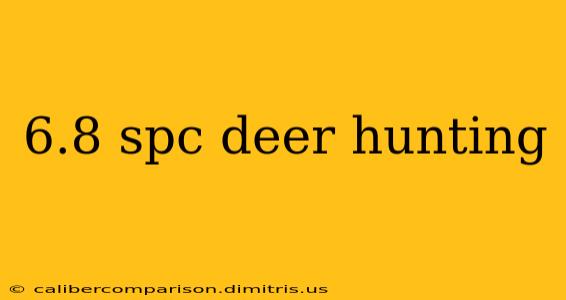The 6.8 SPC (Special Purpose Cartridge) has gained significant popularity among hunters, particularly for deer. Its potent performance and manageable recoil make it a compelling choice for various hunting scenarios. This comprehensive guide delves into the specifics of using a 6.8 SPC for deer hunting, exploring its advantages, disadvantages, ammunition selection, ethical considerations, and more.
Understanding the 6.8 SPC Cartridge
The 6.8 SPC boasts a larger bullet diameter and heavier bullet weight compared to the 5.56x45mm NATO round, resulting in substantially more energy downrange. This increased energy translates to greater stopping power, crucial for ethical and efficient deer harvesting. Its relatively flat trajectory extends effective range, providing hunters with more flexibility in various hunting environments.
Advantages of 6.8 SPC for Deer Hunting:
- Increased Stopping Power: The heavier bullet delivers greater kinetic energy, leading to more humane kills.
- Flatter Trajectory: The bullet retains its velocity over longer distances, improving accuracy at extended ranges.
- Manageable Recoil: Despite its power, the recoil is manageable, facilitating faster follow-up shots if necessary.
- Relatively Low Cost: Compared to some larger calibers, 6.8 SPC ammunition is reasonably priced.
Disadvantages of 6.8 SPC for Deer Hunting:
- Magazine Capacity: Standard magazines often hold fewer rounds compared to AR-15 platforms chambered in 5.56.
- Availability: While increasingly common, ammunition availability might be slightly less widespread than for some more established calibers.
- Rifle Selection: The choice of suitable rifles might be slightly more limited compared to the vast selection available for AR-15 platforms.
Choosing the Right Ammunition for Deer Hunting with 6.8 SPC
Selecting the proper ammunition is crucial for ethical and successful deer hunting. Factors to consider include bullet weight, bullet type, and intended range.
Bullet Weight:
Heavier bullets (e.g., 110-120 grain) offer superior penetration and energy transfer, making them ideal for larger deer. Lighter bullets (e.g., 85-100 grain) are suitable for smaller deer or shorter ranges, but may lack the penetration for larger game.
Bullet Type:
Several bullet types are available for the 6.8 SPC, each with its advantages and disadvantages:
- Full Metal Jacket (FMJ): Primarily used for practice or pest control. Not recommended for deer hunting due to potential for excessive pass-through.
- Soft Point (SP): Designed to expand upon impact, delivering significant energy transfer for humane kills. A popular choice for deer hunting.
- Hollow Point (HP): Similar to soft points, but often expand more rapidly. Suitable for deer hunting but requires careful shot placement.
- Barnes TTSX (Triple Shock X): Known for their consistent expansion and deep penetration, even through bone. A high-quality, albeit more expensive, option.
Ethical Hunting Practices with 6.8 SPC
Ethical hunting practices should always be paramount. This includes:
- Shot Placement: Accurate shot placement is crucial to ensure a quick and humane kill. Aim for vital areas such as the heart and lungs.
- Range Limitations: Understand the limitations of your rifle and ammunition. Avoid shots beyond your effective range.
- Tracking: If a shot is not immediately fatal, be prepared to track the animal.
Conclusion
The 6.8 SPC is a versatile and effective cartridge for deer hunting, offering a balance of power, accuracy, and manageable recoil. By selecting the appropriate ammunition and practicing safe and ethical hunting practices, hunters can maximize their success and ensure a humane harvest. Remember to always comply with all local hunting regulations and obtain the necessary licenses and permits.

